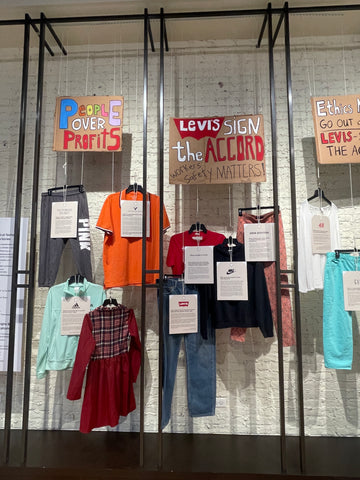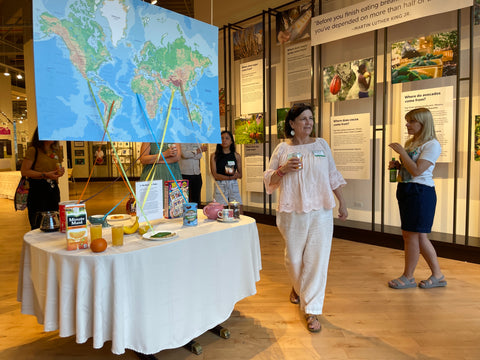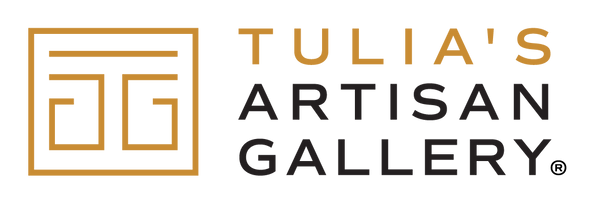Growing up as a Latina and Chicago native, my family members did their best to ensure I knew about my culture. So, they would take me to museums and spend time learning and having fun about the exciting Chicago around us. I am also someone who has a severe shopping obsession. I love finding thrift stores or local businesses where I can continue to build my closet. Hence, the Chicago Fair Trade Museum blends two of my favorite interests of history and shopping. The museum paints an excellent and honest image of the origins of fair trade while having an array of fair trade businesses represented in the museum gift shop. Fairtrade is defined as “trade between companies in developed countries and producers in developing countries in which fair prices are paid to the producers.” (Google Definition) As someone passionate about becoming more environmentally conscious, learning how my shopping impacts the environment opened my eyes to how I take from a world that gives so much.

The museum deep dives into the origins of fair trade, legislation surrounding fair trade, and how fair trade is impacting the world today. The museum discusses the foundation of the World Fair Trade Organization and labor unions within Chicago. The museum's beginning allows those new to fair trade a chance to delve into the rich history of this business format. The text surrounding the origins of fair trade is quite long, so taking time to read, digest, and ask the employees about fair trade is vital when visiting. Next, the museum is engaging as it relates to how corporations have impacted the environment and how fair trade creates a more positive impact. Famous clothing brands cascade a wall and overflow into piles of discarded fast fashion on the floor. Both processed and unprocessed foods are laid out at a breakfast table and connected to a map of where each natural resource comes from. The panels were enjoyable as the text highlighted ways I, as a consumer and civilian, can take action instead of simply throwing information into my face. Frequently, I feel hopeless when educating myself because I don’t know where to start. Understanding where different products have come from, how far they have traveled, and what is in food or fabric that is produced makes change seem possible. The displays are engaging for all ages to understand, which aids in allowing visitors to recognize fair trade principles.

What is especially attractive about the museum is the arrangement of fair trade products available for sale - all sold by local businesses based in Chicago. The museum shop organizes the shop into different categories. Visitors can shop to find home decor, jewelry, chocolates, clothing, and everything in between to take home after their visit. There are options for all price points. In the home decor, my favorite things were the fine art vases made by indigenous Wounaan artists of Colombia. The baskets are large with geometrical shapes of rich red and cream designs, which is emphasized by coil weaving. The baskets are stunning pieces to have in the home as a centerpiece or to place personal belongings. I dream of one day being able to afford one for my home. Truly a work of art. As a fashionista, I could not get enough of the clothing, and the luxurious materials they are made from. The items made of cotton seemed breathable, with unique pigments and colorful prints. A multitude of scarves made of fabric so soft you would want to drape yourself in all the scarves' glitter and elegance. The fair trade clothing is close to the panels about fast fashion so consumers can shop and educate themselves simultaneously! If you do not have the means to get a marvelous basket or new piece for your closet, no worries; there are also snacks made by producers that are affordable as well. Hot chocolate or dark chocolate bites you can snack on. I have never seen so many forms of chocolate in one place! Visitors can contribute to ensuring a more just world by directly supporting producers through fair trade. The museum and its shop prove that change is not about giving up the minor aspects of life we love but becoming conscious about how the things we love come to be. If you have ever felt pessimistic about change or simply want to learn, let the museum broaden your idea of how your choices as a consumer can make a difference.
Overall, the Chicago Fair Trade Museum is a must-see. Whether you are a Chicago native or just passing through, this is a place where you can educate yourself and others while buying the things you love. Touring this museum is an enlightening and unique experience in Chicago that you can share with family and friends. Fairtrade is a business model anyone can support by making a slight difference in our consumption. The museum does a phenomenal job of creating a positive atmosphere that encourages visitors to become a part of a solution for a better tomorrow.

About the Author: Aliya Segura is a Communications major at Columbia College and an aspiring lifelong fair trade consumer.

